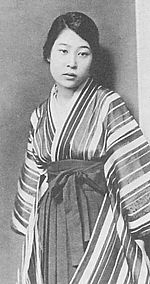Taishō period facts for kids
The Taishō period (大正時代, Taishō jidai), also known as the Taishō era, was a Japanese era name (年号,, nengō,, lit. "year name") after Meiji and before Shōwa. This period started on July 30, 1912 and ended on December 25, 1926. During this time, the emperor was Emperor Taishō-tennō (大正天皇).
The nengō Taishō means "Great Justice" or "Great Righteousness".
Events of the Taishō period
The years in which Taishō was the Japanese monarch comprise this period or era.
- 1920 (Taishō 9): First census of Japan, population 77 million
- 1921 (Taishō 10): Prince Hirohito was made regent (sesshō)
- 1923 (Taishō 12): Great Kantō earthquake;
- 1925 (Taishō 14): Emperor accepts principle of the right to vote for everyone
Politics
- 1912 (Taishō 1): Emperor Meiji died; and Saionji Kinmochi was the Prime Minister during the time of transition.
- 1912 (Taishō 1): Katsura Tarō became 15th Prime Minister of Japan
- 1913 (Taishō 2): Yamamoto Gonbee became 16th Prime Minister
- 1914 (Taishō 3): Ōkuma Shigenobu became 17th Prime Minister
- 1916 (Taishō 5): Terauchi Masatake became 18th Prime Minister
- 1918 (Taishō 7): Hara Takashi became 19th Prime Minister
- 1921 (Taishō 10): Takahashi Korekiyo became 20th Prime Minister
- 1922 (Taishō 11): Katō Tomosaburō became 21st Prime Minister
- 1923 (Taishō 12): Yamamoto became 22nd Prime Minister
- 1924 (Taishō 13): Kiyoura Keigo became 23rd Prime Minister
- 1924 (Taishō 13): Katō Takaaki became 24th Prime Minister
- 1926 (Taishō 15):Wakatsuki Reijirō became 25th Prime Minister
Related pages
Images for kids
-
Prince Regent Hirohito visits Yokohama after 1923 Great Kantō earthquake
-
The Ginza in Tokyo after 1923 earthquake
See also
 In Spanish: Era Taishō para niños
In Spanish: Era Taishō para niños

All content from Kiddle encyclopedia articles (including the article images and facts) can be freely used under Attribution-ShareAlike license, unless stated otherwise. Cite this article:
Taishō period Facts for Kids. Kiddle Encyclopedia.




